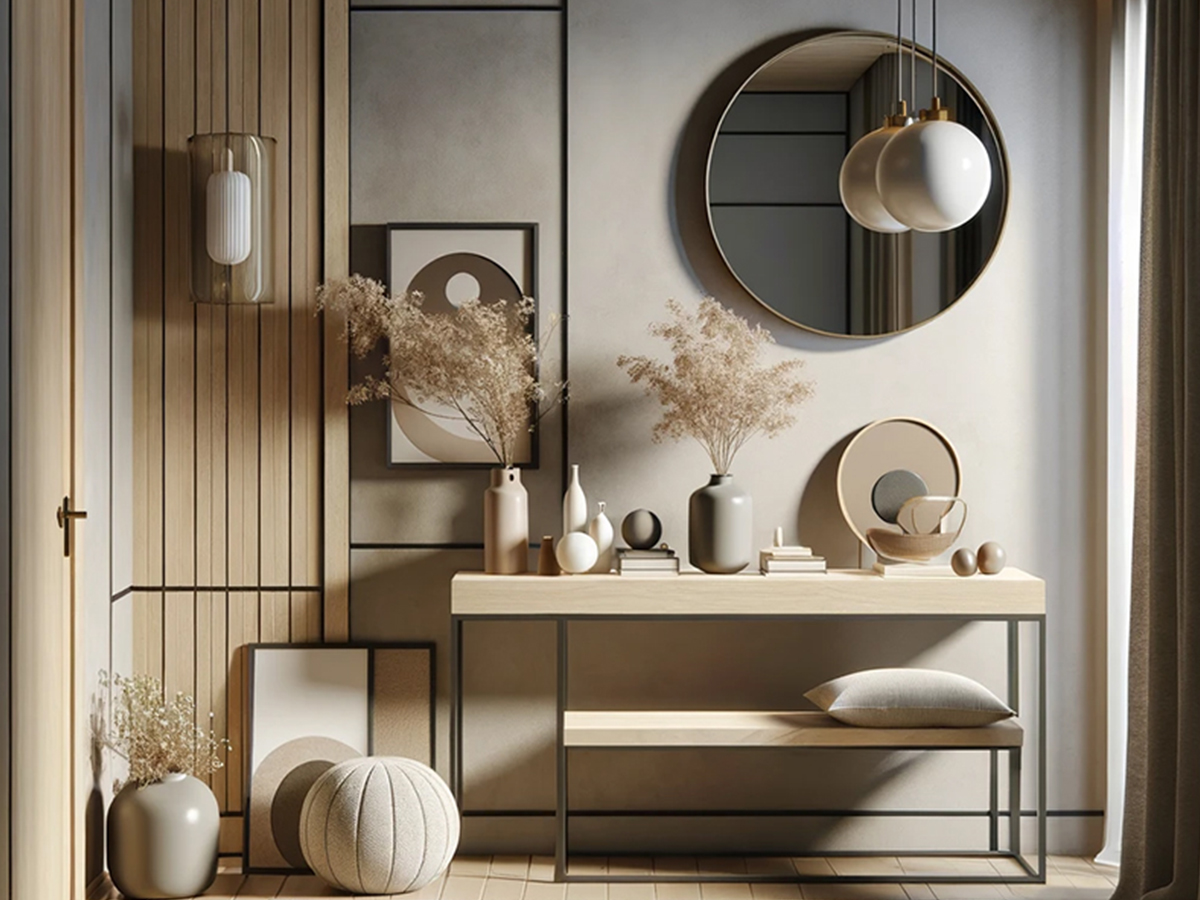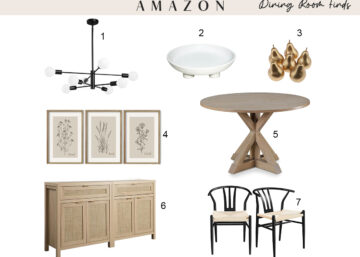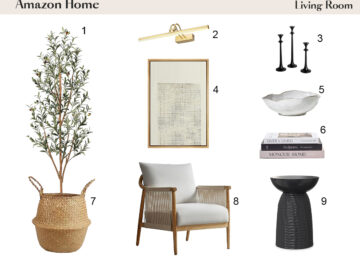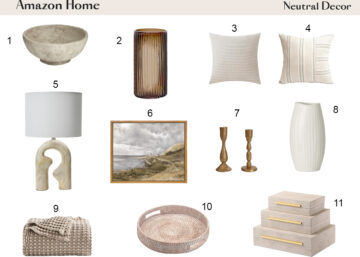Entryway Ideas: Making a Great First Impression
Designing for Space and Function
When it comes to entryways, the dual demands of functionality and aesthetics must be balanced to create a welcoming yet practical space. This section explores innovative design solutions that utilize space efficiently while enhancing the entryway’s functional appeal.
Optimizing Layout
The layout of an entryway is critical as it must accommodate traffic flow while providing necessary storage and comfort. For smaller entryways, consider using multifunctional furniture like a slim console table that includes drawers. This provides a surface for decorative items and storage for keys and mail without crowding the space. In larger entryways, a statement piece such as a bench or a set of chairs can define the space and provide seating for guests to remove shoes or pause for a moment upon entering.
Another seldom-considered approach is the use of vertical space. High ceilings can be utilized with tall installations or art pieces that draw the eye upward, making the area feel more expansive and elegant. For entryways with limited height, attention can be drawn horizontally with detailed wainscoting or a horizontally striped wallpaper design, which can make the space appear wider.
Functional Decor
Incorporating functional decor into the entryway not only saves space but also enhances the overall utility of the area. A mirror strategically placed not only adds depth to the space but also allows for a quick check before leaving the house. Umbrella stands and coat racks can be both ornate and functional, offering places to hold items that would otherwise clutter the space.
For flooring, choosing durable yet attractive materials is crucial since the entryway experiences high foot traffic. Materials like ceramic tile, hardwood, and polished concrete are durable options that can also be stylish. Rugs and mats designed for high-traffic areas can add color and texture while protecting the floor beneath.
Innovative storage solutions like hidden compartments under built-in seating or pull-out shoe racks can keep the entryway clutter-free without compromising style. These solutions are especially valuable in urban homes where space is at a premium but functionality cannot be compromised.
By creatively approaching the design of an entryway, one can ensure that this small but significant area is both beautifully inviting and highly practical, setting a positive tone for the rest of the home or business environment.
Style and Aesthetics
Creating an entryway that resonates with style and aesthetics involves choosing themes, colors, and materials that not only reflect the homeowner’s or business’s personality but also create a cohesive look with the rest of the property. This section explores how thoughtful consideration of these elements can transform an entryway into a visually appealing space that makes a lasting impression.
Choosing a Theme
Reflecting Personality or Brand
The theme of an entryway should serve as an introduction to the aesthetic and ethos of the home or business. For a residential space, this might mean a cozy, welcoming atmosphere that reflects the family’s style and interests. For businesses, the theme should align with the brand’s image, whether it’s professional and sleek for a corporate setting or bold and eclectic for a creative studio. This thematic consistency helps in establishing a strong visual identity right from the entrance.
Cohesiveness with Home or Business Decor
Selecting a theme that seamlessly integrates with the interior design of the rest of the building ensures a unified look. For instance, a modern minimalist home might feature a clean, uncluttered entryway with geometric lines and neutral colors, while a traditional home could opt for classic wood furniture and warm lighting to evoke a sense of history and warmth.
Color Schemes and Materials
Impact of Color
The color scheme of an entryway can dramatically affect the mood and perceived size of the space. Light colors tend to make a space feel larger and more open, ideal for smaller or narrower entryways. In contrast, darker hues can create a feeling of intimacy and grandeur, suitable for larger spaces where a more profound impact is desired. Accent colors can be used to highlight architectural features or artworks, adding depth and interest.
Material Selection for Durability and Style
Choosing the right materials is crucial not only for the entryway’s durability but also for its aesthetic appeal. High-traffic areas require materials that can withstand wear while maintaining their look. For example, hardwood floors or high-quality tiles can offer both durability and beauty. Additionally, elements like brass or chrome fixtures, stone countertops, and luxurious fabrics in furniture or window treatments can convey a sense of quality and attention to detail.
Personalizing with Textures and Patterns
Textural Contrast
Introducing different textures can add visual interest and a tactile element to the entryway. For instance, a combination of rough stone tiles with a smooth wooden console or a soft, plush rug can enhance the sensory experience of the space. Textures also play a practical role; for example, a textured doormat or rug can effectively trap dirt and debris, keeping the rest of the home clean.
Incorporating Patterns
Using patterns wisely can inject personality into the entryway without overwhelming it. Patterned wallpaper, a decorative tile floor, or even a series of framed patterns on the wall can create focal points and add character. It’s important to balance patterned elements with solid colors to avoid visual clutter, especially in smaller spaces.
Lighting the Way
Lighting plays a pivotal role in shaping the atmosphere and functionality of an entryway. Thoughtfully designed lighting schemes can transform these spaces from merely functional passageways to dramatic, welcoming environments. This section will delve into optimizing both ambient and task lighting while incorporating accent lighting to enhance aesthetic appeal and highlight architectural features.
Ambient Lighting
Creating a Warm Welcome
Ambient lighting is the base layer of illumination that ensures the entryway is accessible and inviting. This type of lighting should emit a soft, diffuse glow that fills the space without causing glare or harsh shadows. Ceiling-mounted fixtures, such as chandeliers or flush-mount lights, can serve as both a central light source and a decorative element. For homes with high ceilings, a statement chandelier can add a touch of luxury and draw the eye upward, enhancing the sense of space.
Enhancing Mood with Dimmable Options
The ability to adjust light levels with dimmers can significantly affect the mood and functionality of an entryway. Evening gatherings might call for softer lighting to create a relaxed atmosphere, whereas brighter light may be needed during the day or in darker climates. Dimmable LED fixtures are particularly suitable for this purpose, offering energy efficiency alongside versatility in lighting control.
Accent and Task Lighting
Highlighting Architectural and Decor Features
Accent lighting is essential for drawing attention to the architectural features, artwork, or decorative elements within the entryway. Directed lights, such as track lighting or adjustable wall sconces, can focus light on specific points of interest, enhancing the visual hierarchy of the space. This targeted illumination not only highlights unique architectural details but also adds depth and dimension to the entryway.
Functional Illumination
Task lighting is crucial in areas of the entryway where specific activities occur, such as a console table or a side bench where one might place keys, mail, or sit to remove shoes. Under-cabinet lights, small table lamps, or focused overhead lighting can ensure these areas are well-lit, enhancing functionality without compromising on style. For example, a well-placed pendant light above a console provides sufficient lighting for sorting mail or finding keys, while also serving as a stylish focal point.
Integrating Natural Light
Maximizing Daylight
Incorporating natural light through windows or skylights can dramatically transform an entryway during daylight hours. Natural light not only makes the space feel larger and more open but also offers a changing light play throughout the day, adding a dynamic quality to the entryway. Frosted or tinted glass can provide privacy while still allowing light to penetrate the space, maintaining a connection with the outdoors.
Reflective Surfaces to Enhance Light Distribution
Mirrors strategically placed to reflect both artificial and natural light can amplify lighting effects and make the entryway appear more spacious. Whether used as part of the decor or functionally above a small table for last-minute appearance checks, mirrors are a practical addition that can maximize light distribution throughout the entryway.
Personal Touches and Decor
Adding personal touches and decor to the entryway is an opportunity to infuse the space with character and warmth, making it a true reflection of the homeowner’s or business’s identity. From curated art pieces to green elements, this section explores unique ideas to elevate the entryway beyond mere functionality.
Art and Accessories
Curating a Gallery Wall
A gallery wall in the entryway serves as a focal point, showcasing the homeowner’s or business’s personality and interests. Instead of traditional framed prints, consider displaying unconventional pieces such as textile art, vintage maps, or even a collection of family photographs. Mixing different sizes, shapes, and textures creates visual interest and makes the entryway feel curated rather than cluttered.
Sculptural Elements
Incorporating sculptural elements into the entryway adds dimension and intrigue. Consider introducing a statement sculpture or art installation that complements the overall design theme. Sculptures made from natural materials like wood or stone can bring an organic touch to the space, while metallic or glass sculptures add a contemporary flair.
Green Elements
Indoor Plants
Introducing indoor plants into the entryway not only adds a refreshing pop of greenery but also promotes a sense of well-being. Choose low-maintenance plants such as snake plants, pothos, or succulents that thrive in low-light conditions and require minimal care. Tall potted plants or hanging planters can also help visually soften the space and create a welcoming atmosphere.
Living Walls
For those with a green thumb and a desire to make a bold statement, consider installing a living wall in the entryway. Living walls, also known as vertical gardens, are composed of a variety of plants that grow vertically on a structure attached to the wall. Not only do living walls purify the air and provide insulation, but they also serve as a stunning focal point that immediately captures attention upon entering the space.
Textural Contrast
Incorporating Textiles
Textiles such as rugs, throws, and cushions add warmth and texture to the entryway, making it feel more inviting. Opt for natural materials like wool, cotton, or jute for rugs and throws, as they not only add visual interest but also provide tactile comfort. Layering different textures creates depth and richness, transforming the entryway into a cozy retreat.
Wallpaper and Wall Treatments
Wallpaper and wall treatments are an often overlooked opportunity to introduce texture and pattern into the entryway. Consider using textured wallpaper, grasscloth, or faux finishes to add visual interest to the walls. Additionally, wallpaper with metallic accents or reflective surfaces can enhance the play of light and make the entryway feel more dynamic.
Functional Decor
Entryway Furniture with Storage
Functional furniture pieces with built-in storage are essential for keeping the entryway organized and clutter-free. Choose benches, console tables, or hall trees with hidden compartments or drawers to store shoes, umbrellas, keys, and other everyday essentials out of sight. This not only maximizes space but also maintains a clean and streamlined look.
Multi-functional Mirrors
Mirrors serve a dual purpose in the entryway, both practical and decorative. Opt for mirrors with built-in storage, hooks, or shelves to hold keys, hats, or scarves. Additionally, mirrors can visually expand the space and reflect natural light, making the entryway feel brighter and more spacious.
Technology Integration
Incorporating modern technology into the entryway can enhance convenience, security, and the overall user experience. From smart locks to connected lighting systems, this section explores innovative ways to integrate technology seamlessly into the entryway design, catering to the needs and preferences of both homeowners and businesses.
Smart Locks and Access Control
Keyless Entry Systems
Smart locks offer keyless entry options, allowing homeowners and businesses to unlock doors via smartphone apps, keypads, or even voice commands. This not only eliminates the need for physical keys but also enhances security by providing real-time access control and activity monitoring. For busy households or commercial spaces with frequent visitor turnover, smart locks offer unparalleled convenience and peace of mind.
Remote Access and Monitoring
Many smart lock systems allow users to remotely grant access to guests or service providers, even when they are away from home or the office. This feature is particularly useful for homeowners who want to grant temporary access to delivery personnel or for businesses managing access to multiple employees and contractors. Additionally, integration with smart home security systems enables real-time monitoring and alerts for any unauthorized entry attempts.
Connected Lighting Systems
Automated Lighting Controls
Connected lighting systems offer customizable lighting schemes that adapt to users’ preferences and daily routines. Motion sensors can automatically turn on lights upon entry, providing hands-free illumination and enhancing safety, especially in poorly lit areas. Additionally, scheduled lighting programs can simulate occupancy to deter potential intruders when the space is unoccupied.
Energy Efficiency and Cost Savings
Smart lighting solutions, such as LED bulbs and dimmable fixtures, not only reduce energy consumption but also lower utility costs over time. Integration with smart home hubs or voice assistants allows users to control lighting levels remotely or create energy-saving schedules based on occupancy patterns. For businesses, these energy-efficient lighting solutions contribute to sustainability initiatives while optimizing operational expenses.
Biometric Entry Systems
Fingerprint and Facial Recognition
Biometric entry systems offer advanced security features by using unique biological identifiers such as fingerprints or facial recognition. These systems provide rapid and accurate authentication, eliminating the risk of unauthorized access due to lost or stolen keys or access cards. Biometric entry systems are ideal for high-security environments such as corporate offices, financial institutions, or government facilities.
Enhanced Security and Access Control
In addition to enhancing security, biometric entry systems streamline access control processes by eliminating the need for physical keys or access cards. Authorized users can gain entry with a simple scan of their biometric data, reducing the risk of unauthorized access and improving overall operational efficiency. Moreover, biometric entry systems can be integrated with existing security systems for seamless monitoring and management of access permissions.
Making a Statement
In addition to functionality, the entryway serves as an opportunity to make a bold statement and leave a lasting impression on visitors. From architectural features to decorative accents, this section explores unique ideas for creating an entryway that commands attention and reflects the personality or brand identity of the homeowner or business.
Architectural Elements
Grand Entranceways
For homeowners with ample space and budget, creating a grand entranceway can set the tone for the entire property. Architectural features such as double-height ceilings, sweeping staircases, or arched doorways make a powerful statement and immediately captivate visitors upon arrival. These elements not only add visual drama but also convey a sense of luxury and sophistication.
Unique Door Designs
The entry door is the focal point of the entryway and offers an opportunity for creative expression. Consider customizing the door with unique materials, such as reclaimed wood, wrought iron, or glass panels, to create a striking visual impact. Intricate carvings, bold colors, or oversized door handles can further enhance the door’s aesthetic appeal and make it a standout feature of the entryway.
Statement Furniture and Decor
Eye-catching Furniture Pieces
Introducing statement furniture pieces into the entryway can instantly elevate the space and showcase the homeowner’s or business’s design sensibility. Look for bold pieces with unique shapes, textures, or finishes that demand attention and serve as conversation starters. Whether it’s a sculptural bench, an ornate console table, or a vintage coat rack, the right furniture piece can transform the entryway into a gallery-like space.
Artistic Accents
Incorporating artistic accents into the entryway adds personality and charm while making a bold statement. Consider displaying oversized artwork, statement sculptures, or decorative installations that reflect the homeowner’s or business’s interests and passions. Artistic accents not only enhance the visual appeal of the entryway but also create a sense of intrigue and anticipation for what lies beyond.
Lighting Effects
Dramatic Lighting Fixtures
Lighting fixtures play a crucial role in defining the mood and ambiance of the entryway. Opt for statement lighting fixtures such as oversized chandeliers, sculptural pendant lights, or geometric sconces that make a bold visual statement. These fixtures not only provide functional illumination but also serve as works of art in their own right, adding drama and sophistication to the space.
Play of Light and Shadow
Experimenting with light and shadow can create dynamic visual effects that enhance the architectural features of the entryway. Consider incorporating elements such as recessed lighting, uplighting, or wall washers to highlight textured surfaces, architectural details, or decorative accents. By strategically positioning light sources and adjusting brightness levels, homeowners and businesses can create a captivating interplay of light and shadow that transforms the entryway into a dramatic and enchanting space.
Conclusion
The entryway serves as the gateway to a home or business, offering the first impression to visitors and setting the tone for the entire space. By combining functionality with style, personalization, and technological innovation, homeowners and businesses can create entryways that are not only welcoming and practical but also visually stunning and reflective of their unique identity.
Reflecting Identity and Brand
For homeowners, the entryway is an opportunity to showcase personal style and create a warm, inviting atmosphere that reflects their lifestyle and values. From curated art pieces to green elements and statement furniture, every detail contributes to making the entryway a true reflection of the homeowner’s personality.
For businesses, the entryway serves as a branding opportunity, conveying professionalism, creativity, and attention to detail. Integrating technology, architectural elements, and artistic accents into the entryway design can reinforce the brand identity and leave a memorable impression on clients, partners, and employees.
Elevating the Entry Experience
By incorporating innovative design solutions, such as smart locks, connected lighting systems, and biometric entry systems, homeowners and businesses can enhance convenience, security, and energy efficiency while creating a modern and user-friendly entry experience. From making a bold statement with architectural features to adding personal touches with decorative accents, the entryway becomes more than just a passageway—it becomes a destination in itself.
Setting the Standard for Design Excellence
As technology continues to evolve and design trends shift, the entryway remains a focal point for innovation and creativity in interior and architectural design. By staying informed about emerging technologies, materials, and design principles, Elemental Viz remains committed to providing clients with exceptional 3D rendering, interior design, and floor plan services that exceed expectations and set the standard for design excellence in the industry.








